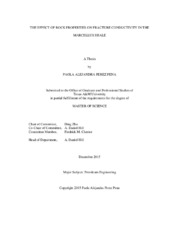| dc.description.abstract | Hydraulic fracturing is a stimulation technique that has made production from unconventional reservoirs such as shale formations economically feasible. This technique creates high conductivity paths that improve the communication between the reservoir and the wellbore. The success of this technique depends on the ability to fracture the rock and to maintain fracture conductivity. Therefore, in order to have a successful treatment, the effect of parameters such as formation properties, type of proppant and proppant concentration on fracture conductivity and fracture creation should be considered.
This work investigates the relationship between fracture conductivity and formation properties for two different locations in the Marcellus shale. Multiple cores from the locations were collected to ensure repeatability in the results. The core samples were fractured parallel and perpendicular to the bedding planes in order to analyze the effect of anisotropy in fracture conductivity. Additionally, compressive triaxial tests were performed to obtain the rock mechanical properties in the elastic region until permanent deformation was reached, and X-ray Diffraction analysis was used to obtain mineralogy composition.
The laboratory results were compared with previous fracture conductivity data and surface roughness data from the same Marcellus shale locations. The findings showed that the anisotropy effect is present for this formation and reflected in the fracture conductivity values, where samples parallel to the bedding plane seem to have higher Young’s Modulus. At proppant monolayer concentration the main mechanism for conductivity loss is proppant embedment, where due to the high localized stress, the rock-proppant interaction goes directly to permanent deformation of the rock. It was also observed that a higher Young’s Modulus helps to maintain the fracture width which translates in lower rate of conductivity loss with increasing closure stress. Rock mechanical properties have impact on fracture conductivity. This effect is less pronounced if a multilayer proppant concentration is used, where the proppant pack characteristics become an important parameter in fracture conductivity. | en |


